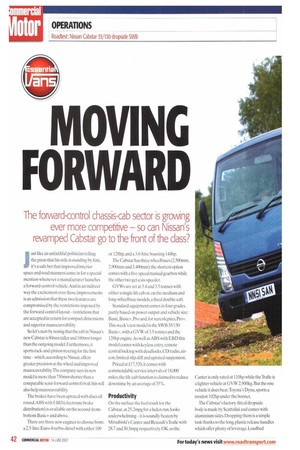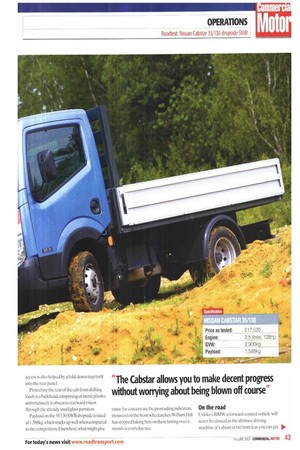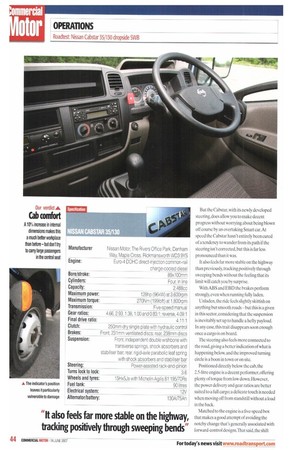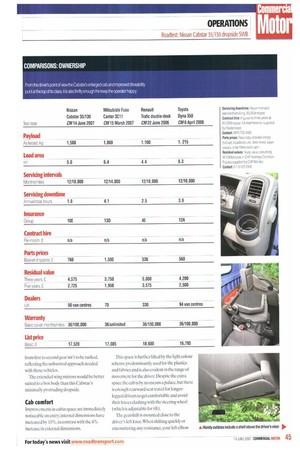111101f NG 1 FORIMAR
Page 42

Page 43

Page 44

Page 45

Page 46

If you've noticed an error in this article please click here to report it so we can fix it.
The forward-control chassis-cab sector is growing ever more competitive — so can Nissan's
revamped Cabstar go to the front of the class?
Just like an unfaithful politician telling the press that his wife is standing by him, it's a safe bet that improved interior space and road manners come in for a special mention whenever a manufacturer launches a forward-control vehicle. And in an indirect way the excitement over those improvements is an admission that these two features are compromised by the restrictions imposed by the forward-control layout -restrictions that are accepted in return for compact dimensions and superior manoeuvrability.
So let's start by noting that the cab in Nissan's new Cabstar is 80mm taller and 100mm longer than the outgoing model, Furthermore, it sports rack-and-pinion steering for the first time which, according to Nissan, offers greater precision at the wheel and improved manoeuvrability.The company says its new model is more than 750mm shorter than a comparable semi-forward-control rival;t his will also help manoeuvrability.
The brakes have been uprated with discs all round;ABS with EBD (electronic brake distribution) is available on the second-frombottom Basic-F and above.
There are three new engines to choose from: a 2.5-litre Euro-4 turbo-diesel with either 109 or 128hp, and a 3.0-litre boasting 148hp.
The Cabstar has three wheelbases (2,500mm, 2,900mm and 3.400mm): the shortest option comes with a five-speed manual gearbox while the other two get a six-speeder.
GVWs are set at 3.4 and 3.5 tonnes with either a single tilt cab or, on the medium and long-wheelbase models, a fixed double-cab.
Standard equipment conies in four grades, partly based on power output and vehicle size: Basic. Basic+,Pro and, for narcoleptics,Pro+. This week's test model is the SWB 35/130 Basic+, with a GVW of 3.5 tonnes and the 128hp engine. As well as ABS with EBD this model comes with keyless entry, remote central locking with deadlocks, CD/radio, aircon, limited-slip diff and uprated suspension.
Priced at £17,520, it comes with commendable service intervals of 18,000 miles:the tilt-cab function is claimed to reduce downtime by an average of 35%.
Productivity On the surface the fuel result for the Cabstar, at 25.2mpg for a laden run, looks underwhelmingit is soundly beaten by Mitsubishi's Canter and Renault's Trafic with 28.7 and 30.5mpg respectively. OK, so the Canter is only rated at 110hp while the Trafic is a lighter vehicle at GVW 2,900kg. But the one vehicle it does beat,Toyota's Dyna, sports a modest 102hp under the bonnet.
The Cabstar's factory-fitted dropside body is made by Scattolini and comes with aluminium sides. Dropping them is a simple task thanks to the long.plastic release handles which offer plenty of leverage. Loadbed access is also helped by a fold-down step built into the rear panel.
Protecting the rear of the cab from shifting loads is a bulkhead comprising of metal planks; unfortunately it obscures rearward vision through the already small glass partition.
Payload on the 35/130 SWB dropsidc is rated at 1,588kg, which stacks up well when compared to the competition. Elsewhere,what might give cause for concern are the protruding indicators. mounted on the front wheelarches:William Hill has stopped taking bets on these lasting over a month in everyday use. On the road Unlike a BMW. a forward-control vehicle will never be classed as the ultimate driving machine; its about as far from it as you can get. 1110' But the Cabstar, with its newly developed steering, does allow you to make decent progress without worrying about being blown off course by an overtaking Smart car.At speed the Cabstar hasn't entirely been cured of a tendency to wander from its path if the steering isn't corrected, but this is far less pronounced than it was.
It also feels far more stable on the highway than previously, tracking positively through sweeping bends without the feeling that its limit will catch you by surprise.
With ABS and EBD the brakes perform strongly, even when running fully laden.
Unladen, the ride feels slightly skittish on anything but smooth roads but this is a given in this sector, considering that the suspension is inevitably set up to handle a hefty payload. In any case, this trait disappears soon enough once a cargo is on board.
The steering also feels more connected to the road, giving a better indication of what is happening below, and the improved turning circle is a boon in town or on site.
Positioned directly below the cab, the 2.5-litre engine is a decent performer, offering plenty of torque from lowdown. However, the power delivery and gear ratios are better suited to a full cargo; a delicate touch is needed when moving off from standstill without a load in the back.
Matched to the engine is a five-speed box that makes a good attempt of avoiding the notchy change that's generally associated with forward-control designs.That said, the shift from first to second gear isn't to be rushed, reflecting the unhurried approach needed with these vehicles.
The extended wing mirrors would be better suited to a box body than this Cabstar's minimally protruding dropside.
Cab comfort
Improvements in cabin space are immediately noticeable on entry; internal dimensions have increased by 10`)/0 • in contrast with the 4% increase in external dimensions. This space is further lifted by the light colour scheme predominantly used for the plastics and fabrics and is also evident in the range of movement for the driver. Despite the extra space the cab is by no means a palace, but there is enough rearward seat travel for longerlegged drivers to get comfortable and avoid their knees clashing with the steering wheel (which is adjustable for tilt).
The gearshift is mounted close to the driver's left knee.When shifting quickly or encountering any resistance, your left elbow knocks against the passenger seat hinge something that grates over time.
There is also a distinct lack of space for the middle passenger due to the intrusion of the engine below the cab, limiting the Cabstar's colleague-carrying ability.
Fortunately there's better news to he had as regards storage.To save width the Cabstar has been built without door bins, but the dash throws in a few welcome surprises.
Above the instrument binnacle is a slim aperture which is ideal for files and the like that need to he close to hand.
There's also a driver's overhead shelf and several cubbies of varying sizes located centrally above the clearly labelled secondary control. Below this is a slim A4 glove box which is just right for paperwork. •


























































































































































































